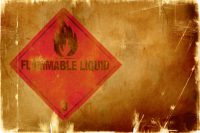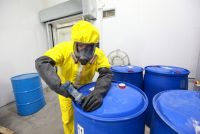Category: Chemicals
Today’s workplace uses thousands of chemicals, many of which are hazardous. The resources in this section will help guide you in the safe and legal identification, storage, transport, and use of these chemicals, and in making sure that your employees right to know how to be safe around such substances is provided, as required by law.
When flammable liquids are involved, the risks are high, and everyone needs to be trained to follow required safety procedures. According to the hazard communication standard (29 CFR 1910.1200), you must train employees who are or may be exposed to flammable liquids to work safely with these substances. Supervisors should also be trained to maintain […]
Understanding the CAA’s General Duty Clause The CAA Amendments of 1990 marked the birth of the GDC, which became effective in November of that year for any stationary source producing, processing, handling, or storing regulated substances or extremely hazardous substance. But the GDC is not an actual regulation, nor can compliance with the GDC be […]
OSHA’s flammable liquids standard (29 CFR 1910.106) explains what these substances are and how to store and use them safely Since the primary hazards associated with flammable liquids are explosion and fire, the standard emphasizes construction and location of storage areas for flammable liquids to prevent buildup of hazardous vapors as well as procedures to […]
Yesterday, we outlined the steps in the process of transitioning to safer chemicals. Today, we review reasons why using safer chemicals whenever possible is a good idea. American workers use tens of thousands of chemicals every day. While many of these chemicals are suspected of being harmful, only a small number are regulated in the […]
The most effective way to control hazardous chemical exposures in the workplace is to eliminate them, but it can be difficult to identify safer alternatives. OSHA has created a toolkit to identify safer chemicals you can use in place of more hazardous ones. The toolkit walks employers and workers through information, methods, tools, and guidance […]
The steps in the decontamination process vary depending on the hazards involved, the equipment available, and the terrain and circumstances. However, this list is typical of what would be set up for a complex decontamination. Station 1: Segregated Equipment Drop Deposit equipment used on-site (tools, sampling devices and containers, monitoring instruments, radios, clipboards) on plastic […]
Decontamination is a vital process for employees who handle hazardous wastes because it removes or neutralizes contaminants that have accumulated on personnel and equipment. Decontamination serves the following purposes: It protects workers from hazardous substances that may contaminate and eventually permeate the protective clothing, respiratory equipment, tools, vehicles, and other equipment used on-site. It protects […]










